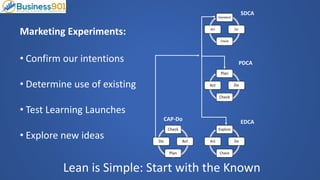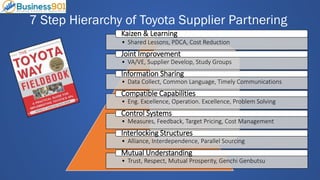Lean Sales & Marketing
- 3. Lean Thinking Practices Standard Do Check Act Explore Do Check Act Plan Do Check Act Plan Do Check Act CAP-Do SDCA Explore Do Check Act Standard Do Check Act Check Act Plan Do PDCA EDCA 3 Ways of Looking at the Lean Cycles of CAP-Do – SDCA – PDCA - EDCA 1. As Tools 2. As Structure 3. As Patterns of Behavior
- 4. Lean is Simple: Find a Problem, Solve a problem Standard Do Check Act Explore Do Check Act Plan Do Check Act CAP-Do SDCA Standard Do Check Act Check Act Plan Do PDCA EDCA Existing Company • Capture what we are doing • Create Standard Work • Improve/regain a standard • Try something new
- 5. Lean is Simple: Explore an Idea, Scale What Works Standard Do Check Act Explore Do Check Act Plan Do Check Act CAP-Do SDCA Explore Do Check Act Check Act Plan Do PDCA EDCA Startups: • Confirm our intentions • Explore our ideas • Test with Learning Launches • Standardize what works
- 6. Lean is Simple: Start with the Known Standard Do Check Act Explore Do Check Act Plan Do Check Act CAP-Do SDCA Check Act Plan Do PDCA EDCA Marketing Experiments: • Confirm our intentions • Determine use of existing • Test Learning Launches • Explore new ideas
- 7. Kaizen & Learning Joint Improvement Information Sharing Compatible Capabilities Control Systems Interlocking Structures Mutual Understanding 7 Step Hierarchy of Toyota Supplier Partnering
- 8. 7 Step Hierarchy of Toyota Supplier Partnering • Shared Lessons, PDCA, Cost Reduction Kaizen & Learning • VA/VE, Supplier Develop, Study Groups Joint Improvement • Data Collect, Common Language, Timely Communications Information Sharing • Eng. Excellence, Operation. Excellence, Problem Solving Compatible Capabilities • Measures, Feedback, Target Pricing, Cost Management Control Systems • Alliance, Interdependence, Parallel Sourcing Interlocking Structures • Trust, Respect, Mutual Prosperity, Genchi Genbutsu Mutual Understanding
- 9. Mutual Understand Interlock Structure Control Systems Compatible Capabilities Info Sharing Joint Improve Kaizen & Learning Current Condition Target ConditionWhere would you be along path?
- 10. 1 to 1 Integrated Solo Selling 1 to Many Interdependent Team Selling Kaizen & Learning Joint Improvement Information Sharing Compatible Capabilities Control Systems Interlocking Structures Mutual Understanding 7 Step Hierarchy of Toyota Self-Actualization Personal Esteem Social Acceptance Security Physical Comfort Salesperson/Acct. Manger oversees integrated actions Salesperson coordinates direct relationships between Orgs 1 to many: Salesperson to Different Departments 1 to 1: Salesperson to Buyer Integrated, Realization of fullest potential Interdependent: Valued by both sides Cooperative: Reduced risk, Forecasting Basic: Operational, Efficient transactions Desire of Organizations MaslowRole/Responsibility of Salesperson
- 11. Kaizen & Learning Joint Improvement Information Sharing Compatible Capabilities Control Systems Interlocking Structures Mutual Understanding Integrated Solo Selling Interdependent Team Selling 1 to Many
- 12. Do: Co-evolving: embody the new in ecosystems that facilitate acting from the whole. Check: Co-initiating: uncover common intent stop and listen to others ACT: Co-sensing: observe and connect with people and places to sense the system from the whole Plan: Co-creating: prototype the new in living examples to explore the future by doing Learning by reflecting on the experiences of the past Learning from the future as it emerges Do Check ACTPlan HOW TO Reflect (CAP-Do)
- 13. Do Check ACTPlan Do Check ACTPlan HOW TO Reflect (CAP-Do)
- 14. Do Check ACTPlan HOW TO Reflect (CAP-Do) What resources will we need? People, Time, Money, Skill • Find Owners • Keep Score • Prioritize What key questions do we need to ask and answer? • Develop Review • Collect Data • Improve Plan How will we know success and for whom? What are the new measures of success? • Monitor Progress • Collective Action What is our minimum trial? What will we learn? • Customer Needs • Determine Drivers • Define Indicators
- 15. Do Check ACTPlan HOW TO Reflect (CAP-Do) P: Pause (Presencing)/Plan • Are the stories clear, concise and relevant? • Stories created in Check = Act (Divergent views are important) • Isolate and group key assumptions • Decide what to: Stop, Continue, Do Different, Start
- 16. Do Check ACTPlan HOW TO Reflect (CAP-Do) D: Do (Enact our Decision) • Stop what we don’t want to do • Create Standard Work for what not to change (SDCA) • Create Hypothesis for what to change (PDCA) • Create Plan to start something new (EDCA)
- 17. HOW TO Reflect (CAP-Do) D: Do (Enact our Decision) • Stop what we don’t want to do • Create Standard Work for what not to change (SDCA) • Create Hypothesis for what to change (PDCA) • Create Plan to start something new (EDCA) SDCA Decisions EDCA Dilemmas PDCA Problems Complexity Uncertainty
- 18. HOW TO Reflect (CAP-Do) SDCA Decisions EDCA Dilemmas PDCA Problems Complexity Uncertainty Integrated Solo Selling Interdependent Team Selling 1 to Many
- 19. HOW TO CREATE STANDARDS (SDCA) Act Std. DoCheck • Commitment – Level of commitment is expected from the individual • Connection – A path for support through conversation is provided (Andon) • Clarification – Minimum standard is explicit • Visualization – Line of Sight • No Budget = No Standard • No Documentation = No Standard • No Strategy
- 20. Act Explore DoCheck HOW TO EXPLORE (EDCA) • Creativity: Envision past ideas to structure, adapting to changes, learning new ideas • Conviction: Deep sense of purpose with the ability to sustain interest and effort in a long- term goal • Challenge: Offers unique perspectives from customer’s viewpoint based on their value and economic drivers
- 21. Act Explore DoCheck HOW TO EXPLORE (EDCA) Evaluate Differently, Not Less: How well plan is executed not the outcome • Sufficient time into planning and analyzing? • Are experiments well constructed? Meet the notion of a minimum viable experiment. • Are predictions getting better? • Are the unknowns (dilemmas) well thought out? • Are changes based on facts or opinions? Are we facing facts quickly and decisively?
- 22. The Importance of EDCA Time Revenue & Product Innovate InnovateDisruptive Innovation • Design Thinking • Blue Ocean Incremental • Red Ocean EDCA • What is your core value stream? • What is the job being done? • What is your promise? • How will you learn? • What will do differently?
- 23. Act Plan DoCheck HOW TO IMPROVE (PDCA) • Concern: Locate the point of concern or cause through Who, What, Where, When • Cause: Identify root cause verifying with data • Countermeasure: · Develop countermeasures utilizing user stories and place on visual board, prioritize
- 24. Determine Sales/Marketing Current State Empower Customers, Engage Prospects, Explore New (work from right to left) 1. Define a value stream based on core product/service and capabilities 2. Complete blue section for key accounts & corresponding green for ourselves 3. Cluster key accounts with other similar customers within value stream 4. Complete blue section for value stream & corresponding green for ourselves 5. Reflect on the process (CAP-Do) and create standard work (SDCA).
- 25. Explore (Pre- Purchase) Engage (Purchase) Empower (Post- Purchase) Future Who your Customer wants to become Place/Platform (Environment) Place/Platform (Environment) Place/Platform (Environment) Product/Service (use of Product) Job we were hired to do Job they wanted done People (Users)People (RAPID) People (Explorers) Process (Interpret Value) Process (How they Decide) Process (How they become aware)
- 26. Explore (Pre_Purchase) Engage (Purchase) Empower (Post_Purchase) Future Customer Who will we become Marketing Process (Extend/Empower) Marketing Process (Establish Value) Marketing Process (Create awareness) Product/Service (What did we Provide) Product/Service (What did we Propose) Product/Service (What did we Promise) People (Supporters) People (Salespeople) People (Marketers) Place/Platform (Environment) Place/Platform (Environment) Place/Platform (Environment)
- 27. Determine Sales/Marketing Current State Empower Customers, Engage Prospects, Explore New (work from right to left) 1. Define a value stream based on core product/service and capabilities 2. Complete blue section for key accounts & corresponding green for ourselves 3. Cluster key accounts with other similar customers within value stream 4. Complete blue section for value stream & corresponding green for ourselves 5. Reflect on the process (CAP-Do) and create standard work (SDCA).
- 28. Existing Customers with New Needs (PDCA) New Customers with New Needs (EDCA) Existing Customers with Existing Needs (SDCA) New Customers with Existing Needs (PDCA) Clusters
- 29. PDCA: Existing Customers with New Needs EDCA: New Customers with New Needs SDCA: Existing Customers with Existing Needs PDCA: New Customers with Existing Needs Lean Re-Sell Re-Gain Retain Renew Refer
- 30. PDCA: Existing Customers with New Needs EDCA: New Customers with New Needs SDCA: Existing Customers with Existing Needs PDCA: New Customers with Existing Needs Lean
- 31. HOW TO Reflect (CAP-Do) D: Do (Enact our Decision) • Stop what we don’t want to do • Create Standard Work for what not to change (SDCA) • Create Hypothesis for what to change (PDCA) • Create Plan to start something new (EDCA) SDCA Decisions EDCA Dilemmas PDCA Problems Complexity Uncertainty
- 32. Funnel of Opportunity Step 1: Key Customers Step 2: Outcome Base Mapping Step 3: Our Promise Step 4: Events/ Moments Step 5: Sales/Market Activities Step 6: Branding Step 7: Resources Investments Step 8: Cluster Step 9: Co-Create Vision Step 10: Identify Adjacencies Step 11: Listening & Learning Step 12: Sustain & Grow
- 33. Applying Kata (Deliberate Practice) to the Cycles of Lean
- 34. SDCA PDCA EDCA CAP- Do Create a Learning Organization Reflection Lean Thinking Practices



































